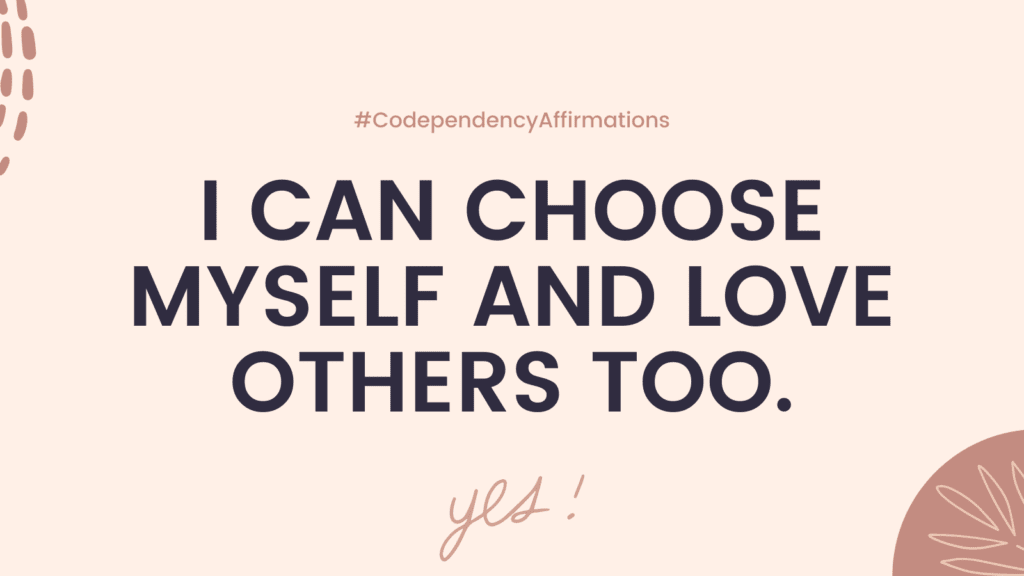Today, you’ll learn all about EFT for codependency and how to use tapping solution to break free from codependency in 5 simple and quick steps.
Tapping on the body’s acupuncture meridian points stimulates the nervous and cognitive systems to clear away negative energy trapped in the body.
EFT has provided relief from hundreds of emotional physical symptoms, such as trauma, stress, anxiety, fears, depression, grief, aches, pains, breathing difficulties, and even codependency.
Does emotional freedom technique really work?
EFT often clears an emotional issue in 5-10 minutes and works where nothing else will, with no side effects.
You may not feel anything different until you revisit the issue you “tapped” on, only to find it much less distressful and even gone altogether.
- What Is Emotional Freedom Techniques (EFT)?
- How Does Emotional Freedom Technique Work?
- 9 Gamut Technique Tapping
- Remaining Round
- EFT For Codependency: How to Break Free From Codependency
- Codependency Serenity Prayer
- Get FREE Overcome Codependency Worksheets
- Adressing Psychological Reversals and Resistance
- Make Tapping a Daily Practice
- FAQ
What Is Emotional Freedom Techniques (EFT)?
Emotional Freedom Techniques, or simply EFT, is evidence-based energy psychology method that can be described as “emotional acupuncture without needles.”
In acupuncture, meridian points on the body are stimulated using needles, pressure or even heat.
Those meridian points are energy pathways with a meridian starting point and a meridian end point.
EFT stimulates these points by tapping or applying pressure on major meridian points to stimulate and balance the left and right brain hemispheres, resulting in a healing effect.
How Does Emotional Freedom Technique Work?
EFT tapping follows a sequence of 5 steps.
Step 1. Define The Issue or Fear You Have
Begin with identifying clearly and specifically the feeling, or problem you want to tap on and release.
Focus on one problem at a time.
Try to be as specific as possible. For example, rather than saying “I’m afraid,” try saying, “I’m afraid about asking for help.”
Step 2. Test the Initial Intensity Level
After you define the problem, rate the intensity level of the emotional or physical pain and discomfort you feel on a scale from 0 to 10, with 10 being the most difficult.
This will help you monitor your progress after completing each EFT sequence.
Step 3. What To Say During EFT Tapping? Define the “Setup Phrase”
Before you begin tapping, you need to define a phrase that:
(1) acknowledges the issue
(2) Communicates that you accept yourself despite this issue
For example, “Even though I have [this problem], I love and accept myself.”
or, “Even though I have [this problem], I deeply and completely accept myself.“
You may alter the phrase so that it fits your issue, but it should not always focus on your own problem and not someone else’s.
For example, instead of saying, “Even though my partner is sick, I completely accept myself,” try saying, “Even though I’m anxious because my partner is sick, I completely accept myself.”
Step 4. Perform the Tapping Sequence: Tapping Therapy Points
There are 14 major meridians end point, each corresponds to an internal organ.
However EFT mainly focuses on these 9 in ascending order:
- karate chop (small intestine meridian)
- eyebrow (bladder meridian)
- side of the eye (gallbladder meridian)
- under the eye (stomach meridian)
- under the nose (governing vessel)
- chin (central vessel)
- beginning of the collarbone (kidney meridian)
- under the arm (spleen meridian)
- top of head (governing vessel)

Use the first two fingers (tap with the pads of your fingers) of either hand to tap. It matters which side, to tap on or which hand you use.
Begin by tapping the karate chop point while simultaneously reciting your setup phrase 3 times.
Then, move on to the other point, taping each point 7 times while simultaneously reciting a “reminder phrase” to maintain focus on your problem area.
For example, if your set up phrase is, “Even though I am afraid, I love and accept myself,” your reminder phrase would be, “I am afraid.”
Finish the sequence by tapping at the top of the head point.
Repeat this sequence two or three times.
Step 5. Test the Final Intensity
At the end of each sequence, rate the intensity level of the problem you feel on a scale from 0 to 10.
If you haven’t reached 0, repeat the process until you reach 0.
9 Gamut Technique Tapping
To further soothe yourself, before closing your sequence and tapping on the crown of your head, try rubbing the Gamut spot – a point on the back of the hand about an inch or so down from the knuckles between the little finger and the ring finger.
Rub the Gamut Spot with one finger while doing the 9 brain-balancing actions:
- Close your eyes
- Open your eyes
- Look hard down to the right
- Look hard down to the left
- Look up as if it were 12:00 on a clock, roll your eyes around clock-wise, to the 3, then down to 6, then to 9, then back up to 12. Stay there and
- Roll your eyes counter clock-wise back over to the 9, down to 6, then to 3 and then up at 12.
- Hum any song (singing activates the left brain)
- Count from 1 to 5 out loud (counting activates the right brain)
- Hum again. Return to tapping
Remaining Round
Remaining round addresses any remaining issues.
It is similar to the basic tapping sequence. The only difference is the setup and reminder phrase.
For example, the set-up phrase for a Remainder Round is: “Even though I STILL HAVE SOME of this fear about confronting my colleague, I love and accept myself.”
The Reminder Phrase for the Remaining Round is: “this remaining fear”.
EFT For Codependency: How to Break Free From Codependency
What Is Codependency?
Codependency is a disorder of selflessness, passivity, and personal powerlessness.
Codependents confuse caretaking with love. Behind their endless devotion a deep longing to be loved and cared for.
Although codependents yearn to be loved, they habitually find themselves in relationships with emotionally unavailable people who need caretaking and end up feeling unappreciated and used.
Codependency Beliefs
Codependents share the following beliefs:
- I am responsible for others safety, health, happiness, and satisfaction.
- Others are unable and incapable of taking care of themselves and managing their loves properly. They need me.
- If others are not happy and satisfied, then I am a failure and have no right to be happy or satisfied.
- My self-worth depends on what others think of me.
- Without others, I cannot be happy or fulfilled
- Others are responsible for my own happiness and wellbeing.
EFT For Codependency
Before you start tapping, identify beliefs you want to change.
After you identified issues and beliefs that you want to change, notice the emotions those beliefs trigger.
For example, setting boundaries may trigger fear that:
- this change would be interpreted as selfishness and indifference,
- that others would feel hurt,
- that others would get angry and may criticize you,
Using tapping, repeat something like, “Even though I feel (afraid) with the idea of (setting healthy emotional boundaries), I deeply and profoundly love and accept myself.”
“I choose (want, deserve, allow myself, accept) to be free from this (fear).
Reminder phrase: “(fear) about (setting healthy emotional boundaries)”
The following are affirmative statements to read while tapping:
- Even though I am afraid of other people, I choose to be free from this fear. (Karate Chop)
- Even though I became an approval seeker and lost touch with myself in the process, I choose to be free from this anxiety. (Eyebrow)
- Even though I am frightened by confrontation and any personal criticism, I choose to be free from this fear. (Side of Eye)
- Even though I have been in codependent relationships, I choose to be free from these regrets. (Under Eye)
- Even though I feel like a victim, I choose to be free from this helplessness. (Under Nose)
- Even though I struggle with perfectionism and asking for help, I choose to be free from this fear. (Chin)
- Even though I confuse love with pity and still find it hard to receive or give real love, I choose to be free from this fear. (Collarbone)
- Even though I feel guilty when I stand up for myself and set boundaries, I choose to be free from this fear. (Under the arm)
- Even though I stuff my feelings and are unable at times to feel or express my feelings because they hurt so much, I choose to be free from this fear. (Top of the head)
Codependency Serenity Prayer
“God, grant me the serenity to accept the things I cannot change, courage to change the things I can, and the wisdom to know the difference.”
Read: Best 20 Must-Read Books On Codependency
Get FREE Overcome Codependency Worksheets
Adressing Psychological Reversals and Resistance
A Psychological Reversal or PR is refers to resistance or self-sabotage.
This self-sabotage is often unconscious. Even though the deep-held belief is negative and limiting you, you may find it hard to let go.
For example, people who have been in depression for so long can find it especially hard to force themselves up out of bed and to move.
When practicing EFT, keep in mind that deciding that EFT won’t work without even trying is a form of resistance and is a normal reaction to change.
Acknowledge your feelings of resistance and practice anyway.
You may start with one sequence of tapping to address your doubts. A good setup phrase could be, “Even though I don’t think EFT will work for me, I love and accept myself.”
Similarly, if you have negative thoughts about releasing an issue, such as “It’s not okay to get over this problem,” or, “It’s not safe to get other this problem,” or, “I’m not ready to get over this problem,” try a sequence of tapping addressing these doubts.
Setup phrases could be:
- “Even though it’s not ok to get over this problem, I love and accept myself”
- “Even though it’s not safe for me to get over this problem, I love and accept myself”
- “Even though I’m worried others will get mad at me, I love and accept myself”
- “Even though I’m not willing to get over, I love and accept myself”
- “Even though I’m not ready to get over, I love and accept myself”
Related: How to Challenge and Change Your Negative Core Beliefs?
Make Tapping a Daily Practice
5 Minute Evening Tapping
At the end of the day, give yourself 5 minutes to do continuous tapping while venting out loud or thinking of all the day’s anger, pain, fear, and anything you want to dump out of your brain.
This will help soothe you, keep stress away, and improve your sleep.
5 Minute Morning Tapping
Start your morning by tapping while saying your morning affirmations, prayers, or simply stating your goals for the day.
Related: The Power of Positive Affirmations: Daily Affirmations for Healing, Wealth, and Happiness
FAQ
What If You Needed to Tap When You’re In Public?
When you are in distress somewhere and you need to soothe yourself, try pressing on one point for 20 – 30 seconds until you calm down.
Try pressing on the spot under your nose, or rubbing your chin or collarbone as if you were “thinking”.
You may also excuse yourself to the restroom and tap there.
References
- Portions of this article were adapted from the book Emotional Freedom Techniques for Codependency Recovery, © 2013 by J.P. Bailey. All rights reserved.
- Clinical EFT (Emotional Freedom Techniques) Improves Multiple Physiological Markers of Health – PMC (nih.gov)
- What is EFT tapping? Evidence and how-to guide (medicalnewstoday.com)
- (PDF) Clinical EFT as an Evidence-Based Practice for the Treatment of Psychological and Physiological Conditions (researchgate.net)
- EFT Tapping: What Is It and Does It Work for Stress? (webmd.com)
- The Lived Experience of Codependency: an Interpretative Phenomenological Analysis | SpringerLink
- Codependency: An Empirical Study from a Systemic Perspective | SpringerLink
- Living with Addicted Men and Codependency: The Moderating Effect of Personality Traits – PMC (nih.gov)



